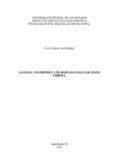| dc.creator | Lindemann, John Lennon | |
| dc.date.accessioned | 2021-12-15T12:26:48Z | |
| dc.date.available | 2021-12-15T12:26:48Z | |
| dc.date.issued | 2021-08-13 | |
| dc.identifier.uri | http://repositorio.ufsm.br/handle/1/23316 | |
| dc.description.abstract | This thesis is divided into four articles, covering different aspects of Lewis Carroll's Logic
and Philosophy of Logic. The first article reproduces three paradoxes presented by Lewis
Carroll, and it examines how Carroll, from his logical tooling, treated such paradoxes
compared to the treatment offered by other authors. The article reproduces the controversy
between Lewis Carroll and John Cook Wilson about the nature of the implication, concluding
that Carroll defended a position congruent with the verifunctional interpretation of the notion
of implication adopted by contemporary logicians. The second article investigates whether the
essential characteristics that define the Smullyan's Tree Method were already present, about
50 years earlier, in the Carroll's Tree Method. After reconstruction of the history of the
development of the tableaux method and the analysis of the essential characteristics of both
authors methods, including a comparison of examples of their applications, we conclude that
the characteristics that define the Smullyan's Trees were already present in Carroll's Trees, in
such a way that, for historical justice, the method should be known as "Carroll-Smullyan's
Trees." This conclusion highlights the significant Carrollian contribution to the development
of Logic, demonstrating the relevance of an investigation into the author's position in the
Philosophy of Logic. The third article presents a notion of nonsense appropriate to Carroll's
works and derived from his theoretical framework, concluding that Carroll used nonsense as a
means of inducing instructive ideas in his readers. The article also compares Carroll and
Wittgenstein's nonsense notion and argues that the two authors had similar attitudes towards
nonsense. The fourth article presents an original hypothesis about Carroll's Philosophy of
Logic, stating that Carroll defended a position analogous to the current pragmatic position. | eng |
| dc.description.sponsorship | Coordenação de Aperfeiçoamento de Pessoal de Nível Superior - CAPES | por |
| dc.language | por | por |
| dc.publisher | Universidade Federal de Santa Maria | por |
| dc.rights | Attribution-NonCommercial-NoDerivatives 4.0 International | * |
| dc.rights.uri | http://creativecommons.org/licenses/by-nc-nd/4.0/ | * |
| dc.subject | Lewis Carroll | por |
| dc.subject | Método de árvores | por |
| dc.subject | Filosofia da lógica | por |
| dc.subject | Nonsense | por |
| dc.subject | Tree method | eng |
| dc.subject | Philosophy of logic | eng |
| dc.title | A Lógica, o Nonsense e a filosofia da lógica de Lewis Carroll | por |
| dc.title.alternative | The Logic, the Nonsense and the philosophy of logic of Lewis Carroll | eng |
| dc.type | Tese | por |
| dc.description.resumo | A presente tese se divide em quatro artigos, abordando distintos aspectos da Lógica e da
Filosofia da Lógica de Lewis Carroll. O primeiro artigo reproduz três paradoxos apresentados
por Lewis Carroll, examinando como tais paradoxos foram tratados por Carroll a partir de seu
próprio instrumental lógico em comparação ao tratamento ofertado por outros autores. O
artigo reproduz a controvérsia entre Lewis Carroll e John Cook Wilson sobre a natureza da
implicação, concluindo que Carroll defendeu uma posição congruente com a interpretação
verofuncional da noção de implicação adotada pelos lógicos contemporâneos. O segundo
artigo investiga se as características básicas que definem o Método de Árvores de Smullyan já
estavam presentes, cerca de 50 anos antes, no Método de Árvores de Carroll. Após uma
reconstrução da história do desenvolvimento dos métodos de árvores de refutação e da análise
das características básicas dos métodos dos dois autores, incluindo o cotejamento de exemplos
de suas aplicações, conclui-se que as características básicas que definem as Árvores de
Smullyan já estavam presentes nas Árvores de Carroll, de tal modo que, por justiça histórica,
o método deveria ser conhecido como “Árvores de Carroll-Smullyan”. Tal conclusão
evidencia a maior contribuição carrolliana para o desenvolvimento da Lógica, demonstrando a
relevância de uma investigação sobre a posição em Filosofia da Lógica do autor. O terceiro
artigo apresenta uma noção de nonsense adequada às obras de Carroll e oriunda de seu
próprio arcabouço teórico, concluindo que Carroll utilizava o nonsense como um meio de
inculcar ideias instrutivas em seus leitores. O artigo também compara a noção de nonsense de
Carroll e Wittgenstein e defende que os dois autores nutriam atitudes análogas em relação ao
nonsense. O quarto artigo apresenta uma hipótese original sobre a Filosofia da Lógica
carrolliana, afirmando que Carroll defendia uma posição análoga à posição pragmática
contemporânea. | por |
| dc.contributor.advisor1 | Sautter, Frank Thomas | |
| dc.contributor.advisor1Lattes | http://lattes.cnpq.br/2804652028967760 | por |
| dc.contributor.referee1 | Teixeira, Rafael Montoito | |
| dc.contributor.referee2 | Sousa, Enne Karol Venancio de | |
| dc.contributor.referee3 | Silva, Mitieli Seixas da | |
| dc.contributor.referee4 | Medeiros, Eduardo Vicentini de | |
| dc.creator.Lattes | http://lattes.cnpq.br/9999572531550043 | por |
| dc.publisher.country | Brasil | por |
| dc.publisher.department | Filosofia | por |
| dc.publisher.initials | UFSM | por |
| dc.publisher.program | Programa de Pós-Graduação em Filosofia | por |
| dc.subject.cnpq | CNPQ::CIENCIAS HUMANAS::FILOSOFIA | por |
| dc.publisher.unidade | Centro de Ciências Sociais e Humanas | por |



